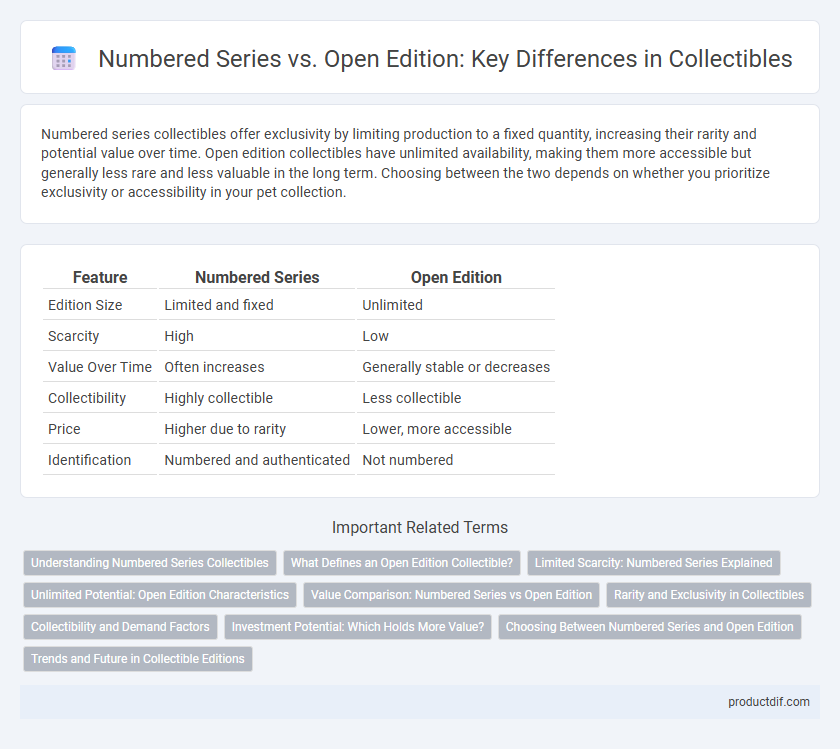Numbered series collectibles offer exclusivity by limiting production to a fixed quantity, increasing their rarity and potential value over time. Open edition collectibles have unlimited availability, making them more accessible but generally less rare and less valuable in the long term. Choosing between the two depends on whether you prioritize exclusivity or accessibility in your pet collection.
Table of Comparison
| Feature | Numbered Series | Open Edition |
|---|---|---|
| Edition Size | Limited and fixed | Unlimited |
| Scarcity | High | Low |
| Value Over Time | Often increases | Generally stable or decreases |
| Collectibility | Highly collectible | Less collectible |
| Price | Higher due to rarity | Lower, more accessible |
| Identification | Numbered and authenticated | Not numbered |
Understanding Numbered Series Collectibles
Numbered series collectibles are limited-edition items assigned a unique number indicating their production sequence, enhancing their rarity and value among collectors. These collectibles often come with certificates of authenticity and precise quantity caps, ensuring exclusivity and desirability in the market. Understanding the significance of numbered series helps collectors make informed decisions by distinguishing scarce items from mass-produced open editions.
What Defines an Open Edition Collectible?
An open edition collectible is characterized by an unlimited number of items produced without a fixed cap, allowing collectors to purchase the piece at any time during its availability. Unlike numbered series, open editions do not include individual numbering or a limited print run, emphasizing accessibility and ongoing demand. This format appeals to collectors seeking affordability and widespread distribution rather than rarity or exclusivity.
Limited Scarcity: Numbered Series Explained
Numbered Series collectibles feature a fixed, limited quantity clearly marked on each item, enhancing their exclusivity and potential value over time due to controlled scarcity. Each piece's unique number within the series guarantees collectors rarity, making these items more desirable in secondary markets. Unlike Open Edition collectibles, which have unlimited production and less scarcity, Numbered Series leverage limited supply to drive demand and investment appeal.
Unlimited Potential: Open Edition Characteristics
Open Edition collectibles offer unlimited potential by allowing creators to produce an unrestricted number of items, maximizing availability and accessibility for collectors. These editions foster broader community engagement and sustained interest through continuous releases without scarcity constraints. Unlike numbered series, open editions emphasize widespread participation, driving dynamic market growth and long-term value through volume and reach.
Value Comparison: Numbered Series vs Open Edition
Numbered series collectibles often hold higher market value due to their limited availability and exclusivity, attracting collectors seeking rarity and investment potential. Open edition items, produced without strict quantity limits, usually have lower value but greater accessibility, making them popular for casual collectors and fans. The scarcity of numbered series directly influences price appreciation over time, whereas open editions typically maintain stable, modest value.
Rarity and Exclusivity in Collectibles
Numbered Series collectibles are limited in quantity, often marked with a unique sequence number, enhancing their rarity and exclusivity among collectors. Open Edition items are produced without a fixed limit, making them more accessible but less valuable due to their widespread availability. The scarcity of Numbered Series significantly drives their market demand and potential appreciation in value over time.
Collectibility and Demand Factors
Numbered Series collectibles feature limited quantities, enhancing scarcity and driving higher demand among collectors who value exclusivity and potential future value appreciation. Open Edition items, produced in unlimited runs, often attract casual buyers due to affordability but typically lack strong investment potential or rarity appeal. Collectibility factors include edition size, provenance, artist popularity, and market trends influencing demand dynamics between these two release types.
Investment Potential: Which Holds More Value?
Numbered series collectibles feature limited quantities, enhancing rarity and often leading to higher long-term investment value due to scarcity and demand-driven appreciation. Open edition items, produced indefinitely, generally hold less investment potential as their abundant supply limits price growth and exclusivity. Collectors seeking appreciation typically prefer numbered series for their proven track record of value retention and market desirability.
Choosing Between Numbered Series and Open Edition
Choosing between a Numbered Series and an Open Edition depends on an investor's preference for rarity versus accessibility. Numbered Series collectibles offer limited quantities with unique numbering, enhancing exclusivity and long-term value potential, while Open Editions remain available indefinitely, making them more affordable and accessible to a broader audience. Understanding market demand and intended collection goals is crucial in selecting the optimal format for investment or personal enjoyment.
Trends and Future in Collectible Editions
Numbered series collectibles maintain higher market value due to their limited supply and verified authenticity, fueling demand among dedicated collectors. Open edition releases, often produced in larger quantities, appeal to casual buyers and drive broader brand engagement but typically lack the rarity that elevates resale prices. Future trends suggest a hybrid approach where digital certificates and blockchain technology enhance provenance, blurring lines between limited and open editions while expanding collectible markets globally.
Numbered Series vs Open Edition Infographic

 productdif.com
productdif.com